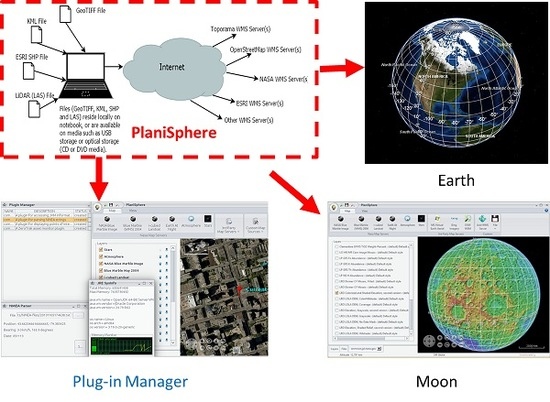Development of Framework for Aggregation and Visualization of Three-Dimensional (3D) Spatial Data
Abstract
:1. Introduction
2. Methodology
2.1. Conceptual Model of Data Aggregations
2.2. Graphic User Interface Design
2.3. Implementation
- a Java SE 1.8 application that can run on any operating system;
- the 3D virtual globe is an interactive application that has a low learning curve;
- open-standard interfaces to GIS services and databases
- capable of rendering in 3D/2D: ESRI shapefiles, GeoTIFF, KML, LiDAR;
- a plugin framework that can be used to expand PlaniSphere by any third party (Figure 4); and,
- capable of rendering in 3D/2D high-resolution imagery, terrain and geospatial information from any source using WMS 1.3.
| Algorithm 1: Algorithm for Graphical Aggregation and Fusion of Geospatial Data refers to Java and NASA World Wind Types such as RenderableLayer, TiledImageLayer, etc. [46,51]. |
|
3. Results and Discussion
4. Conclusions
Acknowledgments
Author Contributions
Conflicts of Interest
References
- Chi, M.; Plaza, A.; Benediktsson, J.A.; Sun, Z.; Shen, J.; Zhu, Y. Big Data for Remote Sensing: Challenges and Opportunities. Proc. IEEE 2016, 104, 2207–2219. [Google Scholar] [CrossRef]
- Ma, Y.; Wang, L.; Liu, P.; Ranjan, R. Towards building a data-intensive index for big data computing—A case study of Remote Sensing data processing. Inf. Sci. 2015, 319, 171–188. [Google Scholar] [CrossRef]
- Guo, H.; Wang, L.; Chen, F.; Liang, D. Scientific big data and Digital Earth. Chin. Sci. Bull. 2014, 59, 5066–5073. [Google Scholar] [CrossRef]
- Yu, L.; Liang, L.; Wang, J.; Zhao, Y.; Cheng, Q.; Hu, L.; Liu, S.; Yu, L.; Wang, X.; Zhu, P.; et al. Meta-discoveries from a synthesis of satellite-based land-cover mapping research. Int. J. Remote Sens. 2014, 35, 4573–4588. [Google Scholar] [CrossRef]
- United Nations; European Commission; Food and Agriculture Organization of the United Nations; International Monetary Fund; Organisation for Economic Cooperation and Development; World Bank. System of Environmental-Economic Accounting 2012: Central Framework, Prepublication (White Cover). Available online: http://unstats.un.org/unsd/envaccounting/White_cover.pdf (accessed on 28 January 2018).
- Wang, J.; Cardenas, L.M.; Misselbrook, T.H.; Gilhespy, S. Development and application of a detailed inventory framework of nitrous oxide and methane emissions from agriculture. Atmos. Environ. 2011, 45, 1454–1463. [Google Scholar] [CrossRef]
- Shrestha, N.K.; Du, X.; Wang, J. Assessing climate change impacts on fresh water resources of the Athabasca River Basin. Sci. Total Environ. 2017, 601–602, 425–440. [Google Scholar] [CrossRef] [PubMed]
- Lokers, R.; Knapen, R.; Janssen, S.; van Randen, Y.; Jansen, J. Analysis of Big Data technologies for use in agro-environmental science. Environ. Model. Softw. 2016, 84, 494–504. [Google Scholar] [CrossRef]
- Vitolo, C.; Elkhatib, Y.; Reusser, D.; Macleod, C.J.A.; Buytaert, W. Web technologies for environmental Big Data. Environ. Model. Softw. 2015, 63, 185–198. [Google Scholar] [CrossRef] [Green Version]
- Wolfert, S.; Ge, L.; Verdouwa, C.; Bogaardt, M.-J. Big Data in Smart Farming—A review. Agric. Syst. 2017, 153, 69–80. [Google Scholar] [CrossRef]
- Daniel, B.K. Reimaging Research Methodology as Data Science. Big Data Cogn. Comput. 2018, 2, 4. [Google Scholar] [CrossRef]
- Hogland, J.; Anderson, N. Function Modeling Improves the Efficiency of Spatial Modeling Using Big Data from Remote Sensing. Big Data Cogn. Comput. 2017, 1, 3. [Google Scholar] [CrossRef]
- Cavallaroa, G.; Riedel, M.; Bodenstein, C.; Glock, P.; Richerzhagen, M.; Goetz, M.; Benediktsson, J.A. Scalable developments for big data analytics in remote sensing. In Proceedings of the IEEE International Geoscience and Remote Sensing Symposium, Milan, Italy, 26–31 July 2015. [Google Scholar]
- Kussul, N.; Shelestov, A.; Lavreniuk, M.; Butko, I.; Skakun, S. Deep learning approach for large scale land cover mapping based on remote sensing data fusion. In Proceedings of the IEEE International Geoscience and Remote Sensing Symposium, Beijing, China, 26–31 July 2016. [Google Scholar]
- Yang, C.; Yu, M.; Hu, F.; Jiang, Y.; Li, Y. Utilizing cloud computing to address big geospatial data challenges. Comput. Environ. Urban Syst. 2017, 61, 120–128. [Google Scholar] [CrossRef]
- Fritz, S.; See, L.; Perger, C.; McCallum, I.; Schill, C.; Schepaschenko, D.; Duerauer, M.; Karner, M.; Dresel, C.; Laso-Bayas, J.-C.; et al. A global dataset of crowdsourced land cover and land use reference data. Sci. Data 2017, 4, 170075. [Google Scholar] [CrossRef] [PubMed]
- Li, J. Assessing spatial predictive models in the environmental sciences: Accuracy measures, data variation and variance explained. Environ. Model Softw. 2016, 80, 1–8. [Google Scholar] [CrossRef]
- Granell, C.; Havlik, D.; Schade, S.; Sabeur, Z.; Delaney, C.; Pielorz, J.; Usländer, T.; Mazzetti, P.; Schleidt, K.; Kobernus, M.; et al. Future Internet technologies for environmental applications. Environ. Model Softw. 2015, 78, 1–15. [Google Scholar] [CrossRef]
- Kuhn, M.; Johnson, K. Applied Predictive Modeling; Springer: New York, NY, USA, 2013. [Google Scholar]
- Shrestha, N.K.; Wang, J. Predicting sediment yield and transport dynamics of a cold climate region watershed in changing climate. Sci. Total Environ. 2018, 625, 1030–1045. [Google Scholar] [CrossRef]
- Maas-Hebner, K.G.; Harte, M.J.; Molina, N.; Hughes, R.M.; Schreck, C.; Yeakley, J.A. Combining and aggregating environmental data for status and trend assessments: Challenges and approaches. Environ. Monit. Assess. 2015, 187, 278. [Google Scholar] [CrossRef] [PubMed]
- Elliott, P.; Wartenberg, D. Spatial Epidemiology: Current Approaches and Future Challenges. Environ. Health Perspect. 2004, 112, 998–1006. [Google Scholar] [CrossRef] [PubMed]
- Cromley, E.K.; Cromley, R.G. An analysis of alternative classification schemes for medical atlas mapping. Eur. J. Cancer 1996, 32, 1551–1559. [Google Scholar] [CrossRef]
- Soulard, C.E.; Acevedo, W.; Cohen, W.B.; Yang, Z.; Stehman, S.V.; Taylor, J.L. Harmonization of forest disturbance data sets of the conterminous USA from 1986 to 2011. Environ. Monit. Assess. 2017, 189, 170. [Google Scholar] [CrossRef] [PubMed]
- Villarreal, M.L.; van Riper, C., III; Petrakis, R.E. Conflation and aggregation of spatial data improve predictive models for species with limited habitats: A case of the threatened yellow-billed cuckoo in Arizona, USA. Appl. Geogr. 2014, 47, 57–69. [Google Scholar] [CrossRef]
- Brewer, C.A.; Pickle, L. Evaluation of Methods for Classifying Epidemiological Data on Choropleth Maps in Series. Ann. Assoc. Am. Geogr. 2002, 92, 662–681. [Google Scholar] [CrossRef]
- Taylor, J.R.; Lovell, S.T. Mapping public and private spaces of urban agriculture in Chicago through the analysis of high-resolution aerial images in Google Earth. Landsc. Urban Plan. 2012, 108, 57–70. [Google Scholar] [CrossRef]
- Kamadjeu, R. Tracking the polio virus down the Congo River: A case study on the use of Google Earth in public health planning and mapping. Int. J. Health Geogr. 2009, 8, 4. [Google Scholar] [CrossRef] [PubMed]
- Lozano-Fuentes, S.; Elizondo-Quiroga, D.; Farfan-Ale, J.A.; Fernandez-Salas, I.; Beaty, B.J.; Eisen, L. Use of Google Earth to Facilitate GIS Based Decision Support Systems for Arthropod-Borne Diseases. Adv. Dis. Surveill. 2007, 4, 91. [Google Scholar]
- Xiong, J.; Thenkabail, P.S.; Gumma, M.K.; Teluguntla, P.; Poehnelt, J.; Congalton, R.G.; Yadav, K.; Thau, D. Automated cropland mapping of continental Africa using Google Earth Engine cloud computing. ISPRS J. Photogramm. Remote Sens. 2017, 126, 225–244. [Google Scholar] [CrossRef]
- Gorelick, N.; Hancher, M.; Dixon, M.; Ilyushchenko, S.; Thau, D.; Moore, R. Google Earth Engine: Planetary-scale geospatial analysis for everyone. Remote Sens. Environ. 2017, 202, 18–27. [Google Scholar] [CrossRef]
- ESRI Team. ArcGIS Software. Available online: https://www.arcgis.com/features/ (accessed on 28 June 2016).
- Bhatt, G.; Kumar, M.; Duffy, C.J. A tightly coupled GIS and distributed hydrologic modeling framework. Environ. Model. Softw. 2014, 62, 70–84. [Google Scholar] [CrossRef]
- Miller, M.; Odobasic, D.; Medak, D. An Efficient Web-GIS Solution based on Open Source Technologies: A Case-Study of Urban Planning and Management of the City of Zagreb, Croatia. In Proceedings of the FIG Congress Facing the Challenges—Building the Capacity, Sydney, Australia, 11–16 April 2010. [Google Scholar]
- Viswanathan, G.; Schneider, M. User-Centric Spatial Data Warehousing: A Survey of Requirements & Approaches. Int. J. Data Min. Model. Manag. 2014, 6, 369–390. [Google Scholar]
- Horsburgh, J.S.; Tarboton, D.G.; Piasecki, M.; Maidment, D.R.; Zaslavsky, I.; Valentine, D.; Whitenack, T. An integrated system for publishing environmental observations data. Environ. Modell. Softw. 2009, 28, 879–888. [Google Scholar] [CrossRef]
- Shu, Y.; Liu, Q.; Taylor, K. Semantic validation of environmental observations data. Environ. Modell. Softw. 2016, 79, 10–21. [Google Scholar] [CrossRef]
- Hallgren, W.; Beaumont, L.; Bowness, A.; Chambers, L.; Graham, E.; Holewa, H.; Laffan, S.; Mackey, B.; Nix, H.; Price, J.; et al. The Biodiversity and Climate Change Virtual Laboratory: Where ecology meets big data. Environ. Modell. Softw. 2016, 76, 182–186. [Google Scholar] [CrossRef] [Green Version]
- PlaniSphere. Available online: www.planisphere.biz (accessed on 28 January 2018).
- GeoServer. An Open Source Server for Sharing Geospatial Data. Available online: http://geoserver.org/ (accessed on 28 January 2018).
- MapServer. Open Source Platform for Publishing Spatial Data and Interactive Mapping Applications to the Web. Available online: http://mapserver.org/ (accessed on 28 January 2018).
- Web Map Service. Open Geospatial Consortium. Available online: http://www.opengeospatial.org/standards/wms (accessed on 28 January 2018).
- OGC. OpenGIS® White Paper. Available online: http://www.opengeospatial.org/docs/whitepapers (accessed on 28 January 2018).
- Gomez, L.; Haesevoets, S.; Kuijpers, B.; Vaisman, A.A. Spatial aggregation: Data model and implementation. Inf. Syst. 2009, 34, 551–576. [Google Scholar] [CrossRef]
- Kimball, R.; Ross, M. The Data Warehouse Toolkit: The Complete Guide to Dimensional Modeling, 2nd ed.; Wiley & Sons: New York, NY, USA, 2002. [Google Scholar]
- NASA. World Wind. Available online: http://worldwind.arc.nasa.gov/features.html (accessed on 28 January 2018).
- Pourabdollah, A. OSM-GB: Using Open Source Geospatial Tools to Create OSM Web Services for Great Britain, FOSS4G, Nottingham. Available online: http://www.academia.edu/4591884/OSM-GB_Using_Open_Source_Geospatial_Tools_to_Create_OSM_Web_Services_for_Great_Britain (accessed on 28 January 2018).
- Herbreteau, V.; Salem, G.; Souris, M.; Hugot, J.P.; Gonzalez, J.P. Thirty years of use and improvement of remote sensing, applied to epidemiology: From early promises to lasting frustration. Health Place 2007, 13, 400–403. [Google Scholar] [CrossRef] [PubMed]
- Boulil, K.; Bimonte, S.; Pinet, F. Conceptual model for spatial data cubes: A UML profile and its automatic implementation. Comput. Stand. Interfaces 2015, 38, 113–132. [Google Scholar] [CrossRef]
- Sarwat, M. Interactive and Scalable Exploration of Big Spatial Data—A Data Management Perspective, Mobile Data Management (MDM). In Proceedings of the 2015 16th IEEE International Conference on Mobile Data Management (MDM), Pittsburgh, PA, USA, 15–18 June 2015; pp. 263–270. [Google Scholar]
- Miu, M. Aggregation of Map (Geospatial) Data. Master’s Thesis, Athabasca University, Athabasca, AB, Canada, 2016. [Google Scholar]
- Wikipedia. Available online: https://www.mediawiki.org/wiki/Extension:GeoData (accessed on 28 January 2018).
- Miu, M.; Zhang, X.; Dewan, M.A.A.; Wang, J. Aggregation and visualization of spatial data with application to classification of land use and land cover. Geoinform. Geostat. 2017, 5, 1–9. [Google Scholar] [CrossRef]
- Shuttle Radar Topography Mission (SRTM). The Mission to Map the World, Jet Propulsion Laboratory, California Institute of Technology. Available online: http://www2.jpl.nasa.gov/srtm/ (accessed on 28 January 2018).
- Lidar. City of Vancouver. Available online: http://data.vancouver.ca/datacatalogue/LiDAR2013.htm (accessed on 28 January 2018).
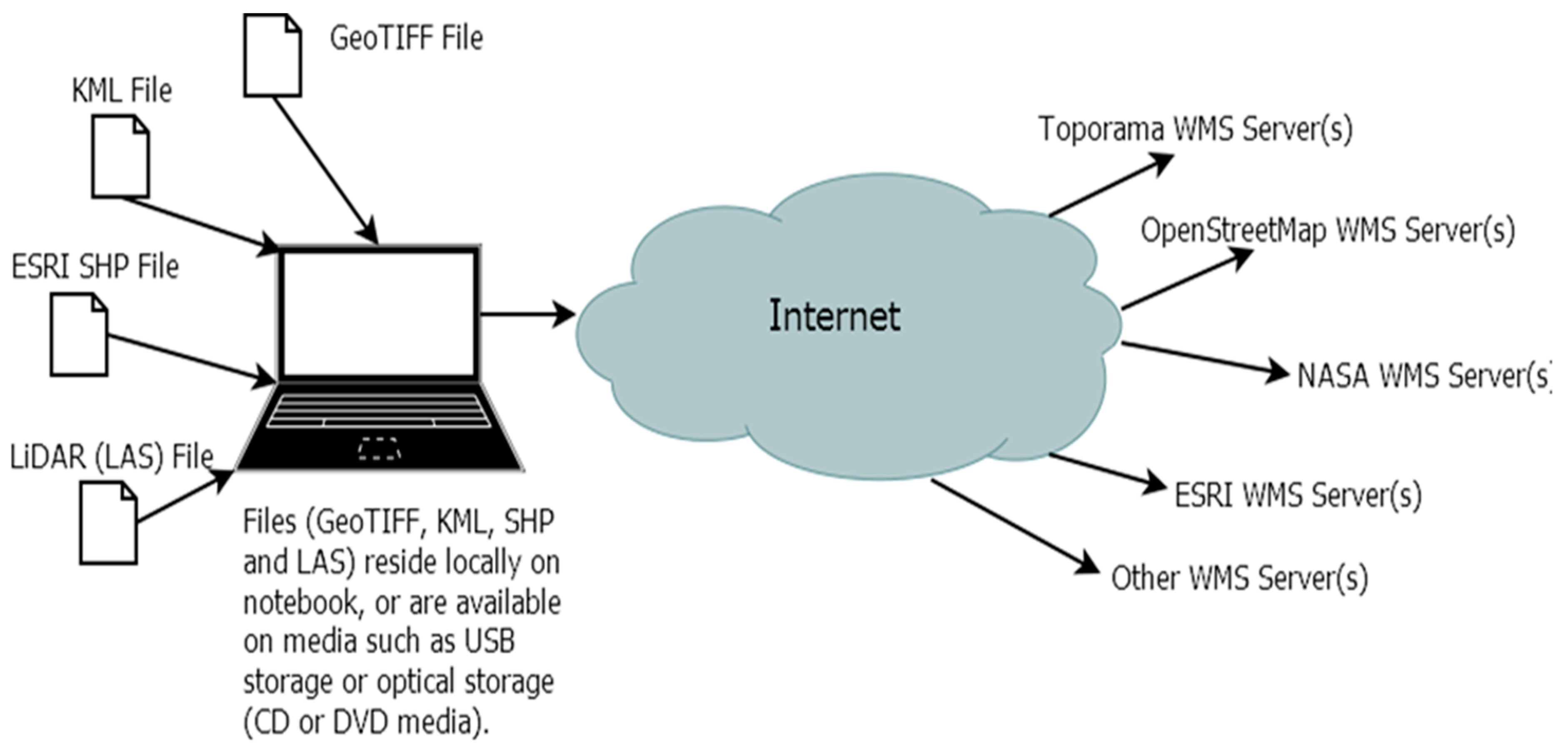
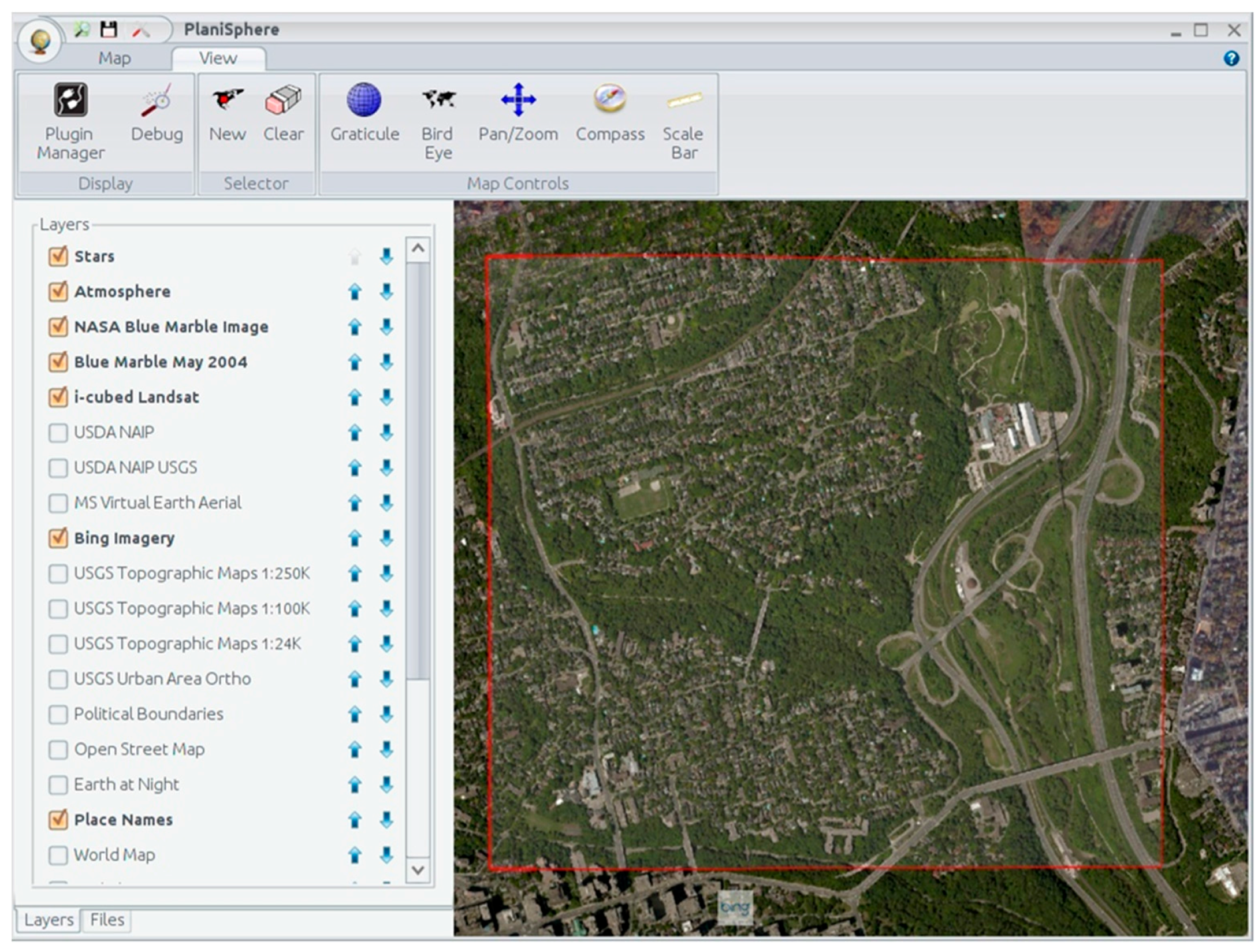
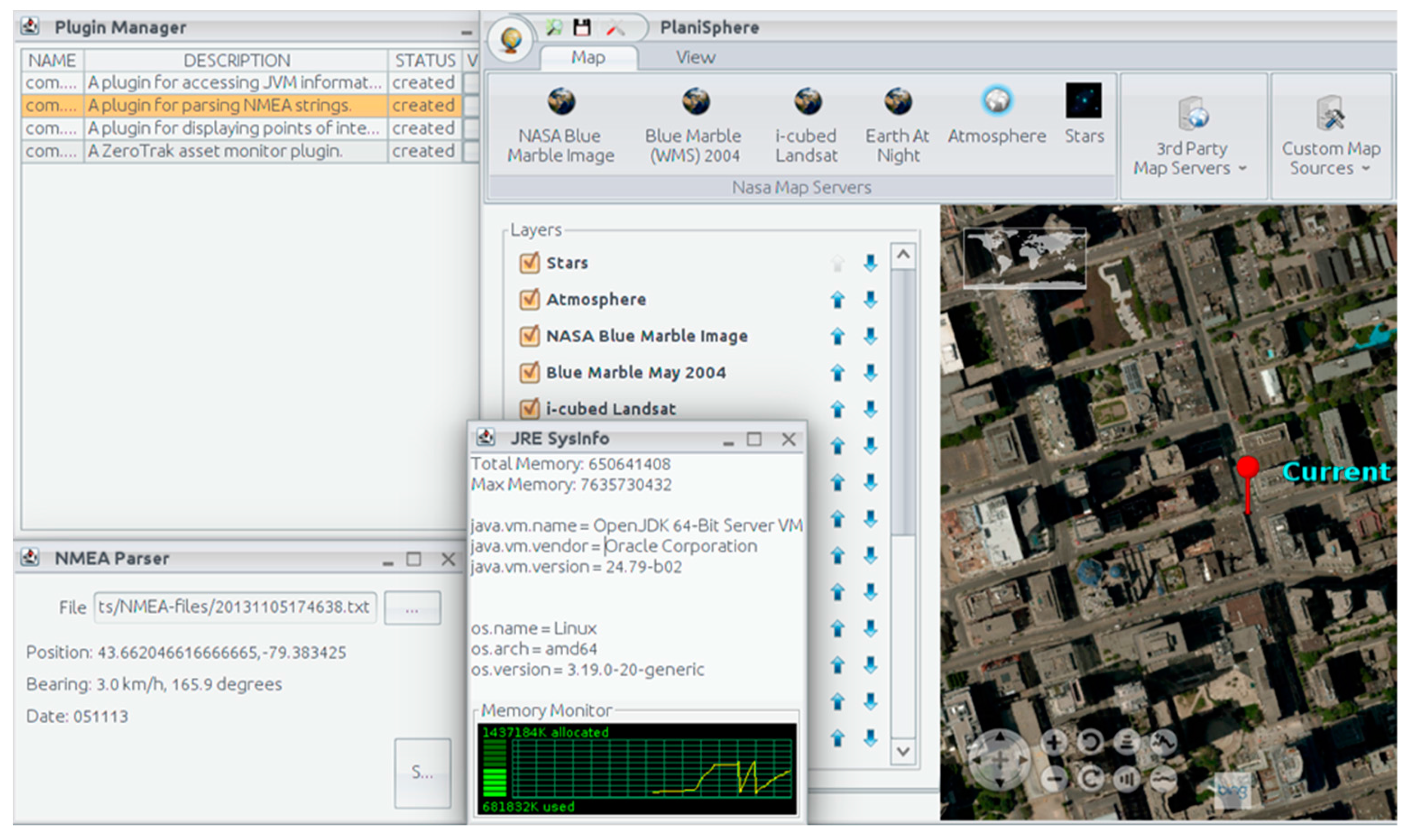
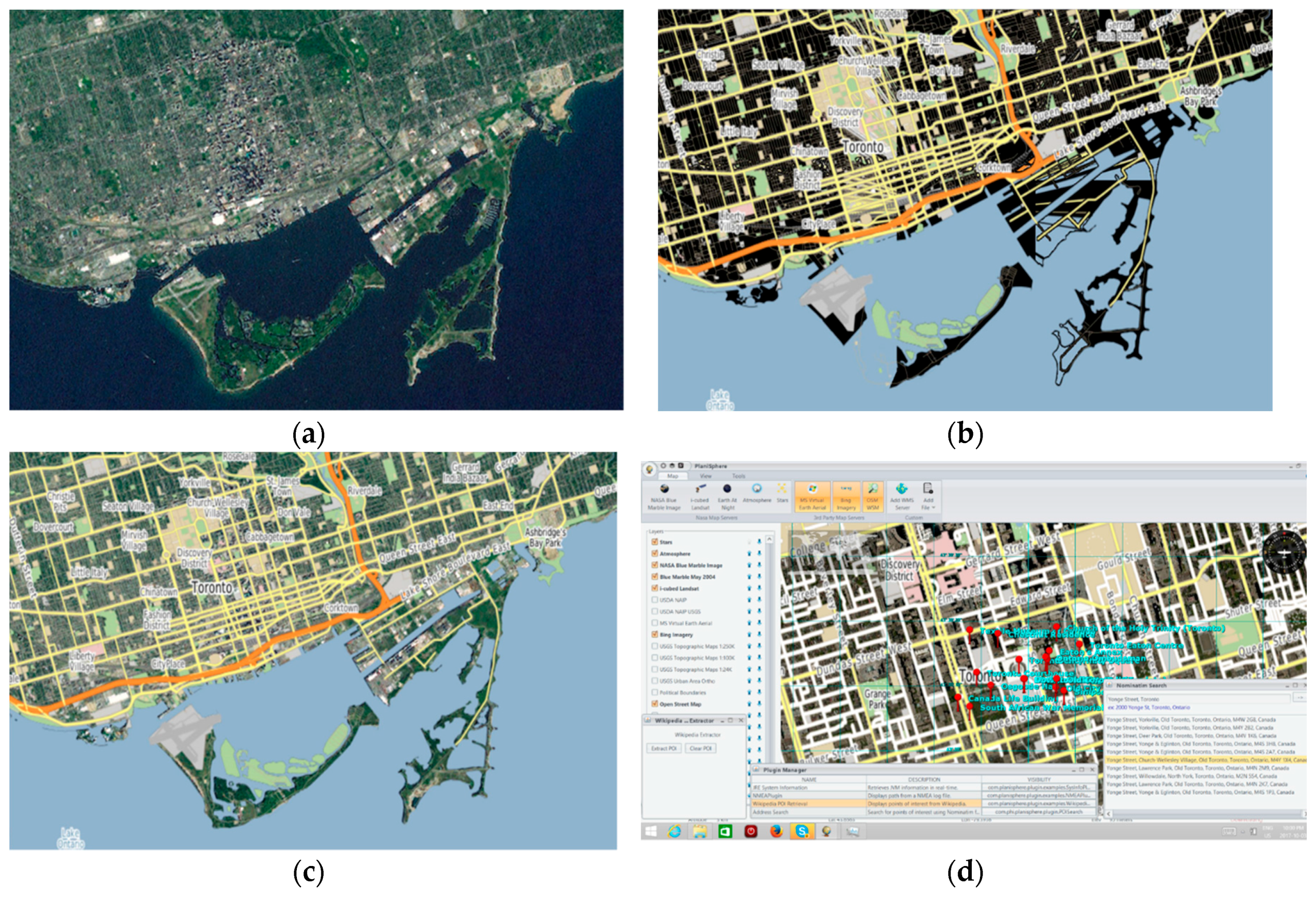
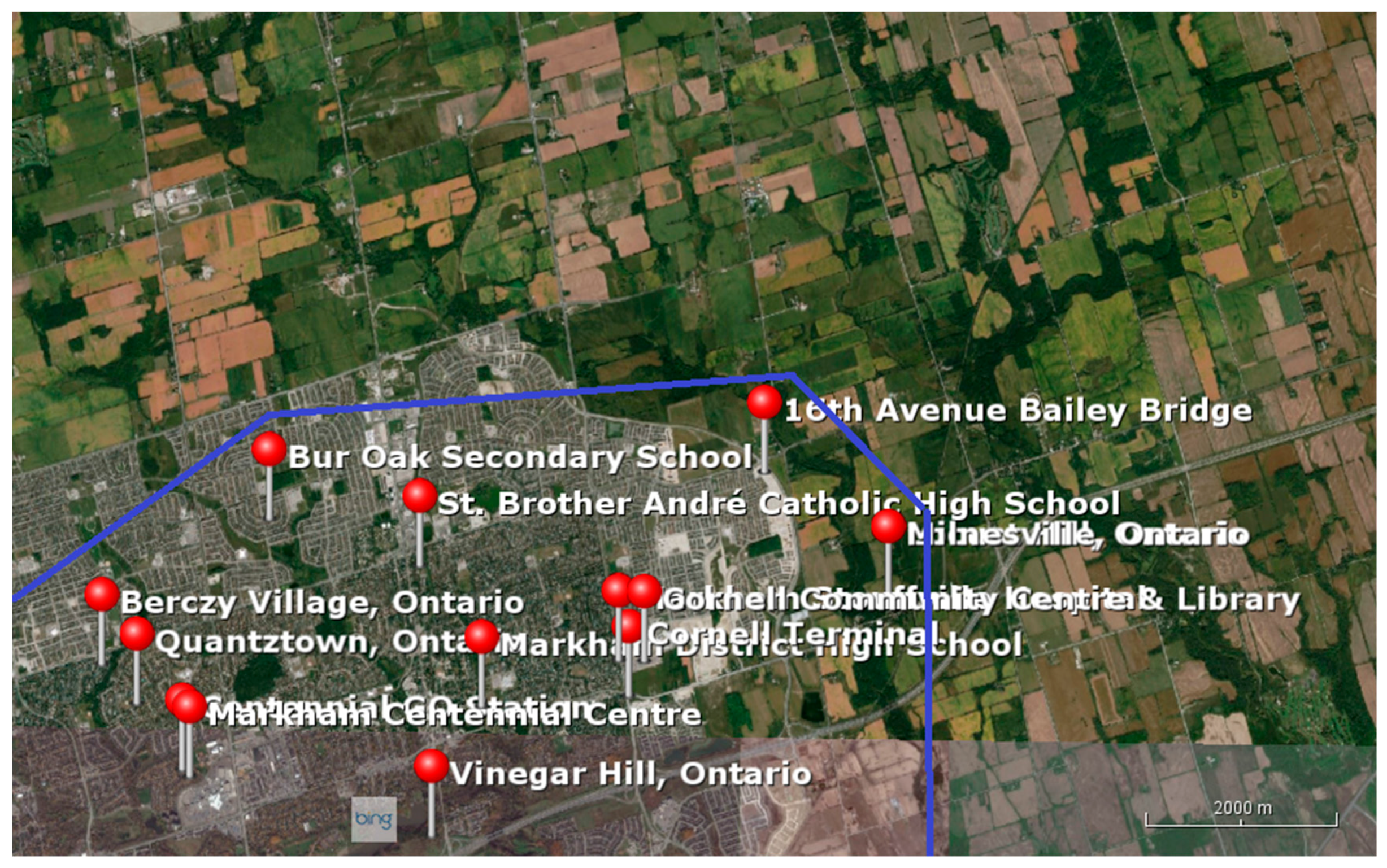
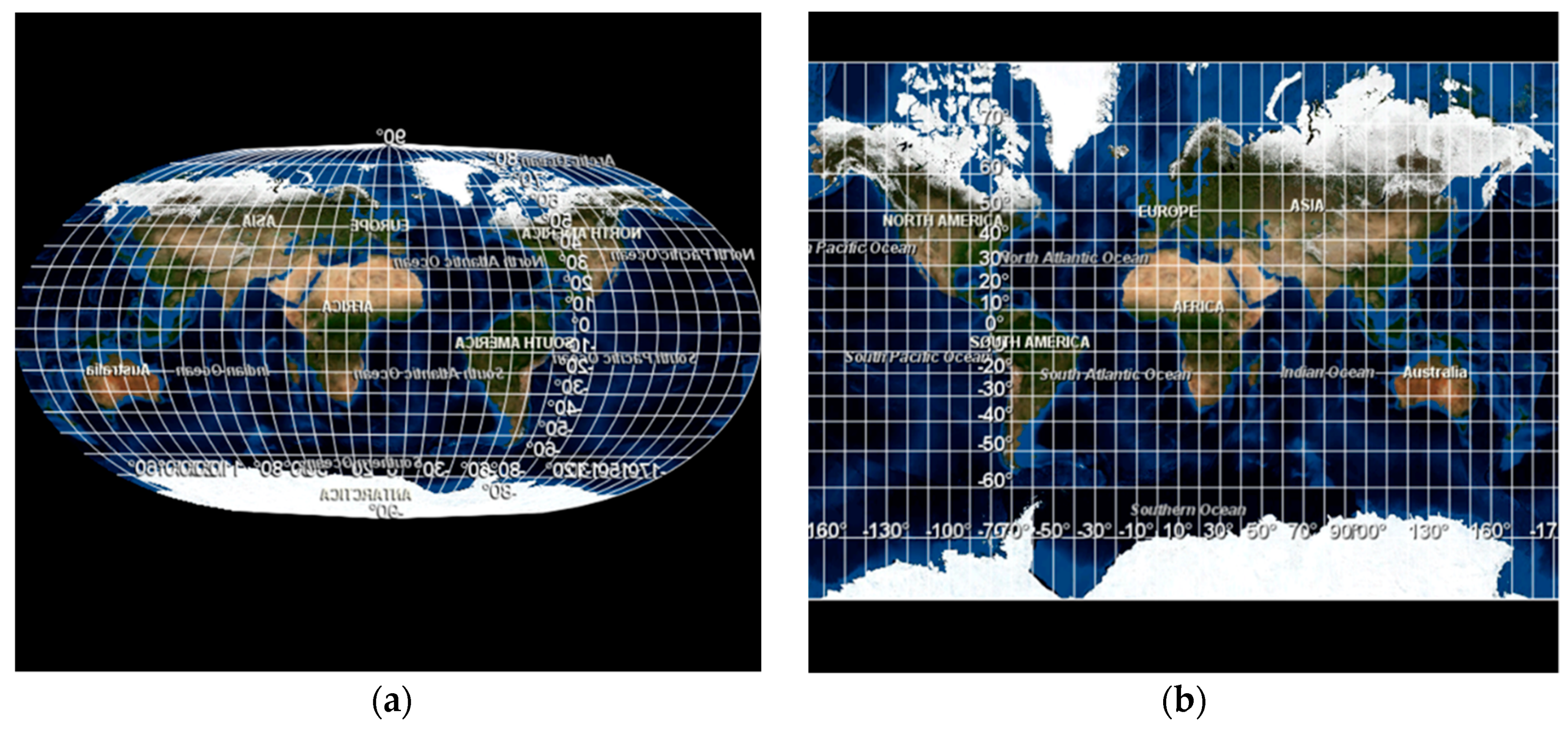
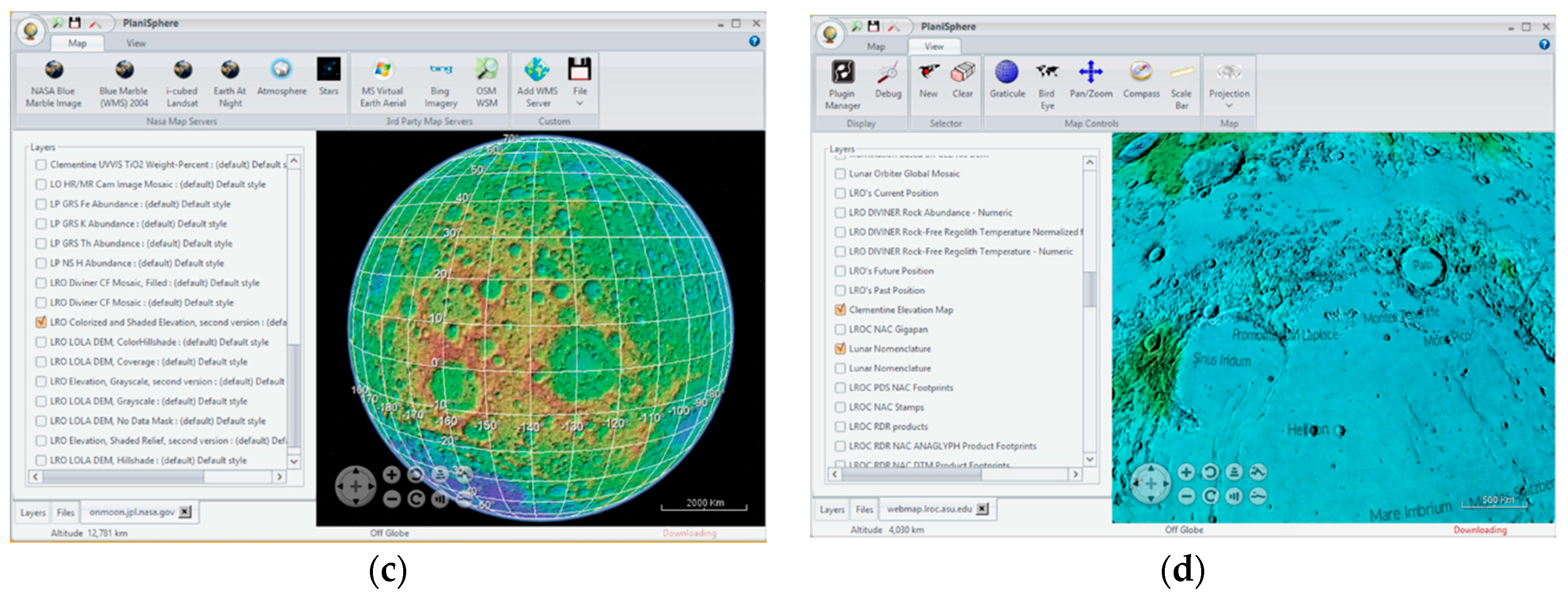
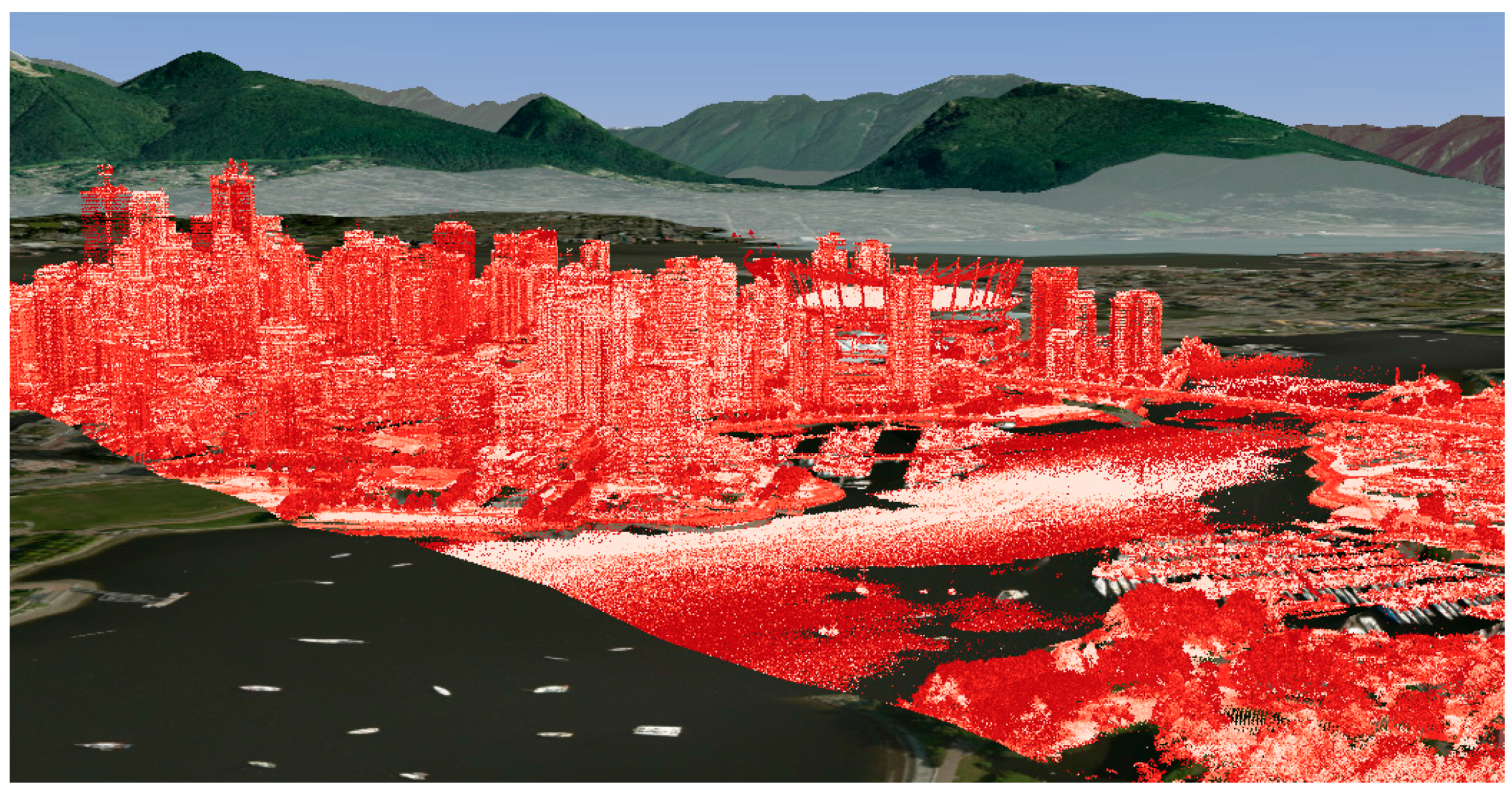
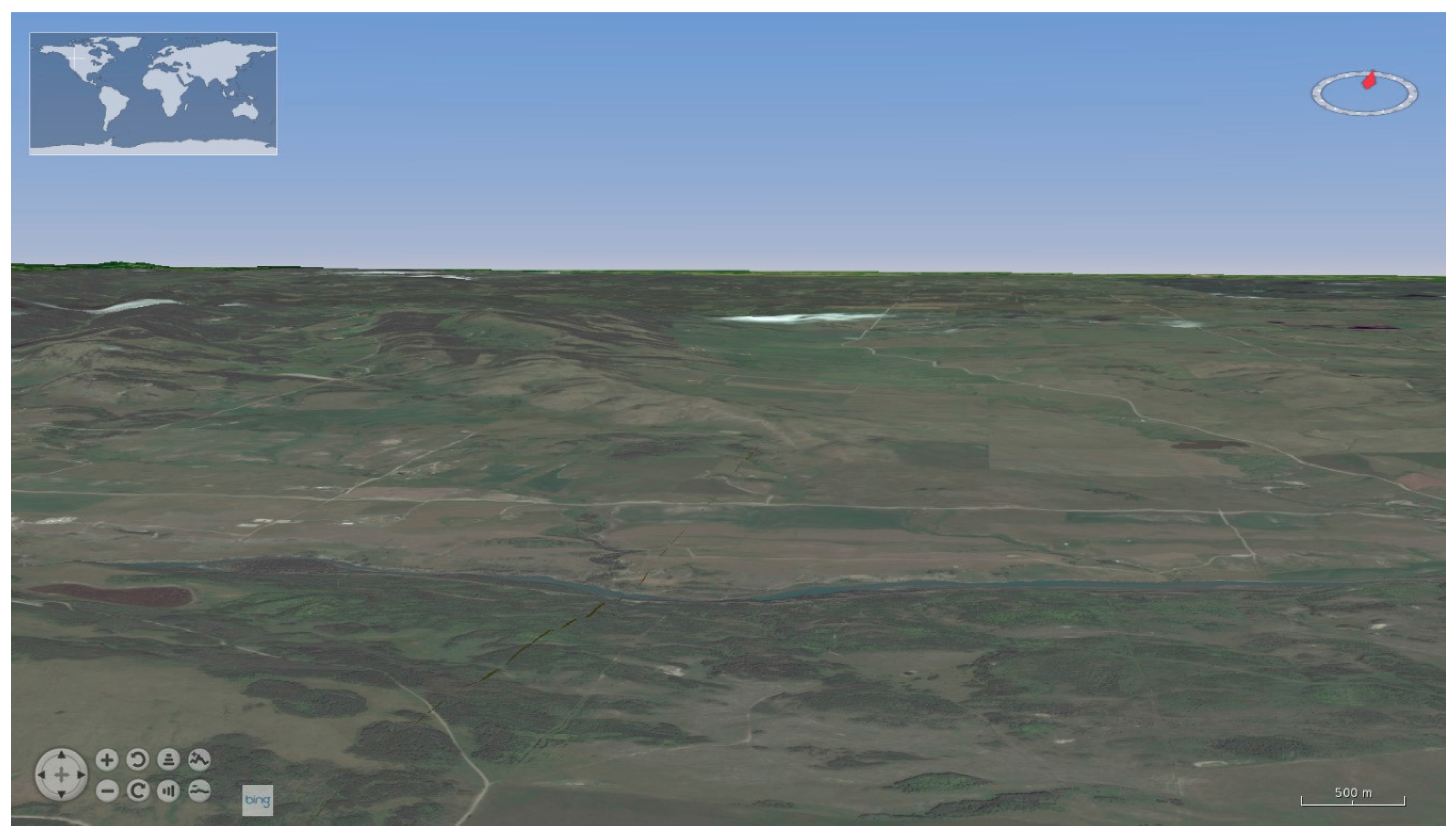
| Native Support (Out of Box Support by Planisphere) | 3rd Party Support | |
|---|---|---|
| Open Sources | Closed Sources | |
| Network/Internet | Local Files | Proprietary Files and Services |
| WMS | GeoJSON | SQL (may be supported by creating a plugin) |
| WFS (currently an experimental feature) | KML | Proprietary files (may be supported by creating a plugin) |
| Raster (TIFF, GeoTIFF) | Custom Web Services (may be supported by creating a plugin) | |
| ESRI Shape Files | ||
| LiDAR (LAS) | ||
© 2018 by the authors. Licensee MDPI, Basel, Switzerland. This article is an open access article distributed under the terms and conditions of the Creative Commons Attribution (CC BY) license (http://creativecommons.org/licenses/by/4.0/).
Share and Cite
Miu, M.; Zhang, X.; Dewan, M.A.A.; Wang, J. Development of Framework for Aggregation and Visualization of Three-Dimensional (3D) Spatial Data. Big Data Cogn. Comput. 2018, 2, 9. https://doi.org/10.3390/bdcc2020009
Miu M, Zhang X, Dewan MAA, Wang J. Development of Framework for Aggregation and Visualization of Three-Dimensional (3D) Spatial Data. Big Data and Cognitive Computing. 2018; 2(2):9. https://doi.org/10.3390/bdcc2020009
Chicago/Turabian StyleMiu, Mihal, Xiaokun Zhang, M. Ali Akber Dewan, and Junye Wang. 2018. "Development of Framework for Aggregation and Visualization of Three-Dimensional (3D) Spatial Data" Big Data and Cognitive Computing 2, no. 2: 9. https://doi.org/10.3390/bdcc2020009




